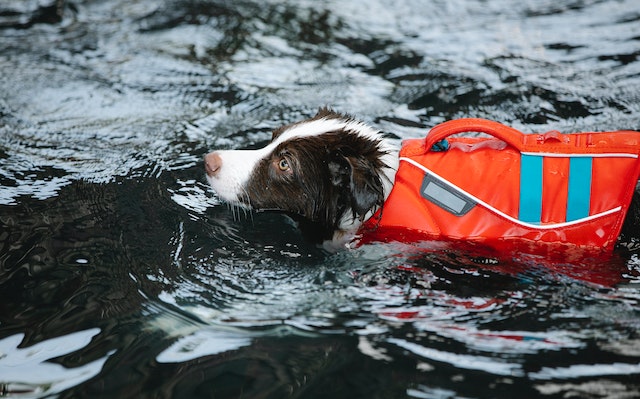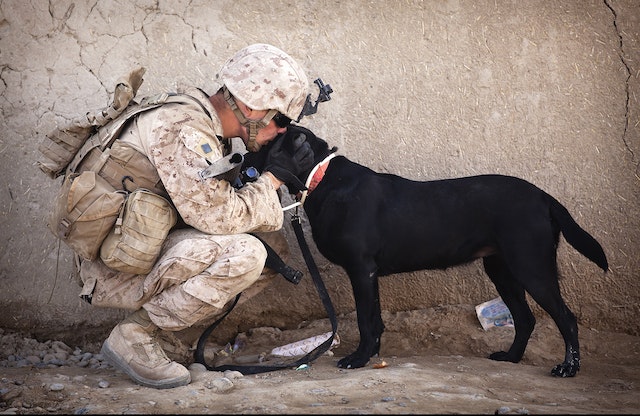Professional Uses of Dogs in Many Sectors
Dogs are not just used as pets but in various professions too. Let’s look at some of the areas of work in which dogs are used as:
Law enforcement: Dogs are trained to work in law enforcement agencies, such as police departments, border patrol, and security agencies. They are used for tasks such as tracking, search and rescue, detecting drugs or explosives, and apprehending criminals.
Search and rescue: Dogs are trained to assist in search and rescue operations, such as locating missing people in wilderness areas or disaster zones.
Therapy and service animals: Dogs are trained to provide emotional support and assistance to people with disabilities or medical conditions. They can help with tasks such as opening doors, retrieving objects, and providing comfort and companionship.
Hunting: Dogs are used in hunting for tasks such as tracking game, retrieving birds, and flushing out prey.
Agriculture: Dogs are used on farms and ranches for tasks such as herding livestock, guarding property, and controlling pests.
Entertainment: Dogs are used in the entertainment industry, such as in movies, television shows, and live performances.
Medical research: Dogs are used in medical research for tasks such as drug testing, disease research, and surgical training.
Dog Use in Law Enforcement
Dogs are extensively used in law enforcement agencies for a wide range of tasks due to their exceptional sense of smell, hearing, and agility. Here are some of the ways dogs are used in law enforcement:
Tracking: Dogs are trained to track and follow the scent of a person or object, making them valuable in locating suspects who have fled the scene of a crime.
Narcotics and explosive detection: Dogs are trained to detect illegal drugs, explosives, and other hazardous materials, helping law enforcement agencies to identify and apprehend criminals.
Search and rescue: Dogs are used in search and rescue operations, helping to locate missing persons, whether they are lost in the wilderness, trapped under rubble, or in other dangerous situations.

Apprehension: Some dogs, such as German Shepherds and Belgian Malinois, are trained to apprehend suspects who try to escape law enforcement officers.
Crowd control: Dogs can also be used for crowd control and riot control, helping to disperse unruly crowds or deter violent behavior.
K-9 units: Many law enforcement agencies have dedicated K-9 units, which consist of police officers and their trained dogs. These units provide additional support and resources for law enforcement operations.
Dogs are essential tools for law enforcement agencies, providing additional capabilities and enhancing the overall effectiveness of law enforcement operations.
Dogs’ Role in Rescue and Research
Dogs are highly trained and valuable assets in search and rescue operations. Here are some of the ways dogs are used in search and rescue:
Tracking: Dogs are trained to track and follow the scent of a person or object, making them valuable in locating missing persons who are lost in the wilderness or other areas.
Air scenting: Some dogs are trained to use their sense of smell to detect airborne scents. They can pick up scents from far away and follow them to locate people who are lost or trapped.
Cadaver search: Some dogs are trained to detect the scent of human remains, helping to locate victims of natural disasters, accidents, or crimes.
Water rescue: Some dogs are trained in water rescue, able to locate and retrieve drowning victims or assist in boat rescues.
Avalanche rescue: Specialized dogs are trained to work in avalanche rescue situations. They are trained to locate people buried under snow and alert rescuers to their location.
Urban search and rescue: Dogs are used in urban search and rescue operations, such as after earthquakes or building collapses. They can locate survivors trapped under rubble or debris.
Dogs Use in Therapy
We have already covered the use of dogs in therapy and what kind of dogs you need according to your living situation.
Uses of Dog in Hunting
Dogs are commonly used in hunting for various tasks. Here are some of the ways dogs are used in hunting:
Retrieving: Retrievers, such as Labrador Retrievers and Golden Retrievers, are commonly used for retrieving games, such as ducks or geese, that have been shot by the hunter. These dogs are trained to swim and retrieve birds from the water or land.
Pointing: Pointers, such as German Shorthaired Pointers and English Pointers, are used for locating game birds, such as quail or pheasant. These dogs use their sense of smell to locate birds and then point toward them, signaling their location to the hunter.
Flushing: Spaniels, such as English Springer Spaniels and Cocker Spaniels, are used for flushing game birds out of hiding places, such as tall grass or brush. These dogs run through the cover, flushing out the birds so that the hunter can take a shot.
Tracking: Hounds, such as Beagles and Bloodhounds, are used for tracking game, such as rabbits or deer. These dogs use their sense of smell to follow the scent trail of the animal and alert the hunter to its location.
Protection: Some hunting dogs, such as German Shepherds and Rottweilers, are used for protection during hunting trips. These dogs can protect the hunter from dangerous animals, such as bears or wild boars, and can also guard the hunting campsite.
Dogs’ Use in Agriculture
Dogs are commonly used in agriculture for various tasks. Here are some of the ways dogs are used in agriculture:

Herding: Dogs are commonly used for herding livestock, such as sheep, cattle, and goats. Herding dogs, such as Border Collies, Australian Shepherds, and Welsh Corgis, are trained to control the movements of livestock, driving them to specific locations or keeping them from wandering off.
Guarding: Some dogs, such as Great Pyrenees, Anatolian Shepherds, and Maremma Sheepdogs, are used for guarding livestock against predators, such as wolves, coyotes, or wild dogs. These dogs live with the livestock, forming a bond with them and protecting them from harm.
Vermin control: Dogs can be trained to control pests, such as rats, mice, and rabbits, which can damage crops or cause other problems on the farm.
Detection: Dogs can be trained to detect pests or diseases in crops, such as citrus greening disease in citrus groves or bacterial wilt in tomato fields.
Transportation: Some dogs, such as sled dogs, are used for transportation in cold regions where motorized vehicles are not practical.
Uses of Dogs’ in Entertainment
Dogs have been a popular subject in entertainment for decades, and their charm, intelligence, and loyalty make them perfect for various roles. Here are some of the ways dogs are used in entertainment:

Movies: Dogs have appeared in many movies, from classic films like Lassie and Old Yeller to modern films like Marley & Me and A Dog’s Purpose. These movies often feature dogs as central characters or as companions to the human actors.
TV shows: Dogs have been featured in numerous TV shows, both in live-action and animated form. Examples include the animated series Scooby-Doo and the live-action series Dog Whisperer with Cesar Millan.
Circus: Dogs have been trained to perform tricks and stunts in circuses, such as jumping through hoops or balancing on balls. However, the use of animals in circuses is controversial, and many countries have banned the practice.
Stage shows: Dogs have appeared in various stage shows, from musicals like Annie to productions of Shakespeare’s Two Gentlemen of Verona, where a dog plays a key role.
Commercials: Dogs have been featured in many commercials, often promoting products for pet owners, such as dog food or toys.
Dogs for Medical Purposes
Dogs are commonly used for medical purposes due to their exceptional sense of smell, trainability, and loyalty. Here are some of the ways dogs are used for medical purposes:
Service dogs: Service dogs are trained to assist people with physical or mental disabilities. For example, dogs can be trained to help people with visual impairments navigate their surroundings or to help people with mobility impairments by retrieving items, opening doors, or turning on lights.
Therapy dogs: Therapy dogs are used to provide comfort and emotional support to people in hospitals, nursing homes, and other healthcare settings. These dogs are trained to be calm, friendly, and non-reactive to a variety of stimuli.
Detection dogs: Detection dogs are used to identify specific scents, such as drugs, explosives, or diseases. For example, dogs can be trained to detect low blood sugar in people with diabetes, or to detect certain types of cancer in humans.
Search and rescue dogs: Search and rescue dogs are trained to locate missing people or victims of natural disasters, such as earthquakes or avalanches. These dogs use their sense of smell to locate people who may be trapped or injured.
Allergy detection dogs: Allergy detection dogs are trained to identify allergens, such as peanuts, and alert their owners to their presence. These dogs can help people with severe allergies avoid exposure to allergens that could trigger an allergic reaction.
Doglime for more canine-related information.










